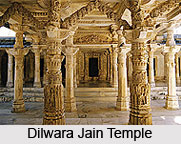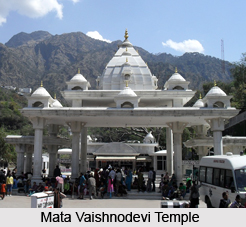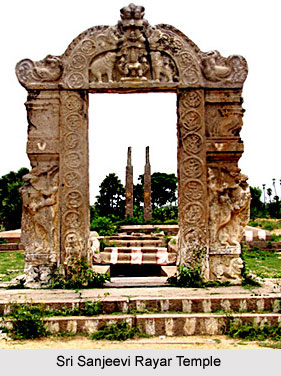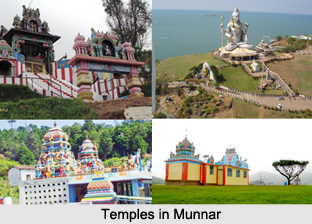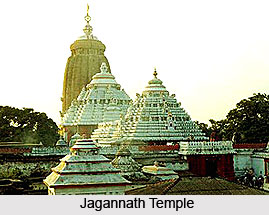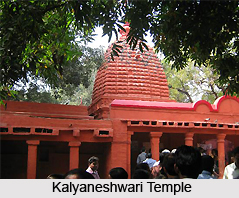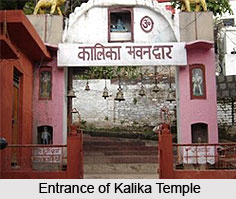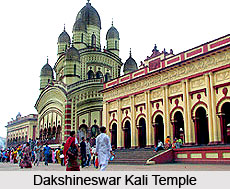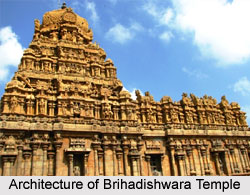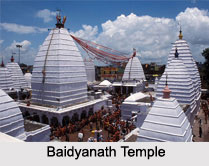 Baidyanath Temple, popularly known as "Baidyanath Dham", is in the state of Jharkhand. It has been referred to by various names like "Harda Peetha", "Ravan-Van", "Haritki-Van" and "Ketaki-Van" in different ancient sources. Baidyanath Temple is dedicated to Lord Shiva. It is believed that the Baidyanath Dham in Deoghar is associated with legendary stories of Ravana and Lord Shiva. The three important fairs held here are "Shri Panchami Mela" held in January, "Shivaratri Mela" held in March and the "Bhadra Purnima Mela" held in September. The Shivaratri Mela is attended by several visitors in the course of a fortnight. One can get all kinds of prosperity and long life by praying in this holy place.
Baidyanath Temple, popularly known as "Baidyanath Dham", is in the state of Jharkhand. It has been referred to by various names like "Harda Peetha", "Ravan-Van", "Haritki-Van" and "Ketaki-Van" in different ancient sources. Baidyanath Temple is dedicated to Lord Shiva. It is believed that the Baidyanath Dham in Deoghar is associated with legendary stories of Ravana and Lord Shiva. The three important fairs held here are "Shri Panchami Mela" held in January, "Shivaratri Mela" held in March and the "Bhadra Purnima Mela" held in September. The Shivaratri Mela is attended by several visitors in the course of a fortnight. One can get all kinds of prosperity and long life by praying in this holy place.
Legends of Baidyanath Temple
There are several legends regarding the Baidyanath Temple. In the Treta Yuga, Ravana, the King of Lanka propitiated Lord Mahadeva and wanted him to come over to Lanka. Mahadeva did not accept his penance. However he was told that one of the 12 emblems of his divinity, "Jyotirlingam", would be quite as effective as his presence and that he might take it away on the condition that there should be no break in the journey and the lingam would not be deposited anywhere on the earth. If the lingam was put anywhere on the earth in the course of the journey, it would be fixed on that spot for ever. Ravana agreed to this condition and took the lingam and started his journey back to Lanka. The gods feared the effect of this. A trick was devised and Lord Varuna, the god of the waters, entered Ravana"s stomach and the demon had to descend to earth to relieve him. Later, Lord Vishnu disguised as an old Brahmin, appeared before Ravana, after his descent to the earth, and began to converse with him. 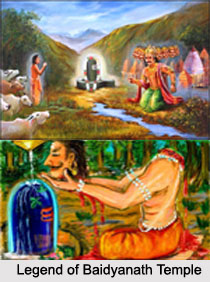 Ravana requested the Brahmin to kindly hold the Jyotirlingam for a few minutes so that he could ease himself. He readily agreed to it and, as soon as Ravana turned, he left the Jyotirlingam on the spot and vanished. When Ravana came back, he found that the Jyotirlingam was fixed to the earth and realised that a trick had been played on him. He tried his best to remove the lingam and even broke a piece off the top of the lingam. He failed to remove the Lingam and made his obeisance to the lingam. It was at this place Ravana cut off his nine heads to repent and Lord Shiva blessed him by joining back all his heads like a "Vaidya". Daily he used to come from Lanka and worship it. The spot where Ravana came down to the earth has been identified with “Harlajuri†and the place where the lingam was deposited is known as "Deoghar".
Ravana requested the Brahmin to kindly hold the Jyotirlingam for a few minutes so that he could ease himself. He readily agreed to it and, as soon as Ravana turned, he left the Jyotirlingam on the spot and vanished. When Ravana came back, he found that the Jyotirlingam was fixed to the earth and realised that a trick had been played on him. He tried his best to remove the lingam and even broke a piece off the top of the lingam. He failed to remove the Lingam and made his obeisance to the lingam. It was at this place Ravana cut off his nine heads to repent and Lord Shiva blessed him by joining back all his heads like a "Vaidya". Daily he used to come from Lanka and worship it. The spot where Ravana came down to the earth has been identified with “Harlajuri†and the place where the lingam was deposited is known as "Deoghar".
According to Padma Purana, a Brahmin in the garb of Lord Vishnu, after taking the lingam from Ravana, consecrated it with water from a neighbouring tank. There was a Bhil present who had to do whatever was instructed to him. The Bhil had informed Ravana regarding the disappearance of the Brahmin. Ravana excavated a well known as "Chandra Kupa" with an arrow and brought into it the waters of all the sacred pools of the earth.
Another legend is when Sati, the consort of Shiva and daughter of Daksha, committed suicide because of the rudeness shown towards her husband by Daksha in not inviting him to a Yajna. Lord Shiva stuck his wife"s dead body on the point of his trident and roamed about in a frenzy of fury. Vishnu cut the dead body with his discus into 52 parts which fell in different parts of India and became "Shakti Peetha Sthan". It is believed that the heart of Sati fell at Deoghar.
Structure of Baidyanath Temple
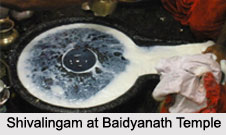 This temple faces the east and is a plain stone structure with a pyramidal tower. This rises from a square base to a height of 72 feet from the ground. To the east of the northern verandah of the temple there is a large vat into which flows the water and milk that is offered as ablution. The lingam is of a cylindrical form which is around 5 inches in diameter and projects about 4 inches from the centre of a large slab of basalt. The Shivalingam here is adorned majestically with jewels and pearls. The top part of the lingam is broken and has uneven surface. This Jyotirlingam here is in the form of a Vaidya (doctor). He is supposed to relieve the devotees of their dreadful diseases.
This temple faces the east and is a plain stone structure with a pyramidal tower. This rises from a square base to a height of 72 feet from the ground. To the east of the northern verandah of the temple there is a large vat into which flows the water and milk that is offered as ablution. The lingam is of a cylindrical form which is around 5 inches in diameter and projects about 4 inches from the centre of a large slab of basalt. The Shivalingam here is adorned majestically with jewels and pearls. The top part of the lingam is broken and has uneven surface. This Jyotirlingam here is in the form of a Vaidya (doctor). He is supposed to relieve the devotees of their dreadful diseases.
The temple has different porches. One of the porches leads to the cell where the lingam is fixed. The second porch is in the front with a row of pillars spanned by blocks of basalt. On the right side there is a sandstone image of Nandi (bull). There are bells fixed in the ceiling and pilgrims are supposed to pull the bell-ropes in order to announce their approach to the divinity. The courtyard has 11 temples. There is a large tank known as "Shiva-Ganga" or "Manasarovara".












